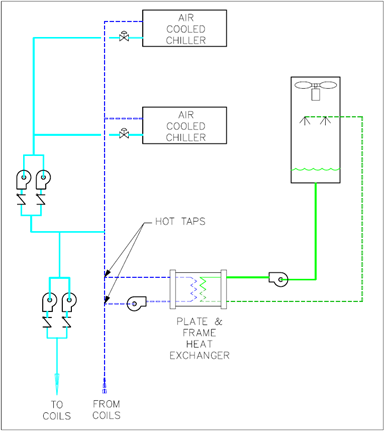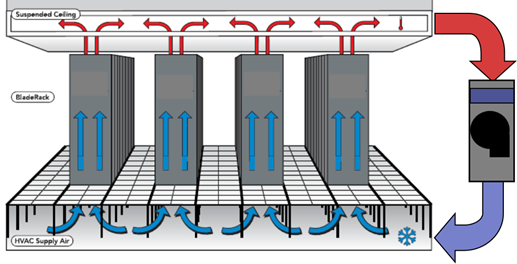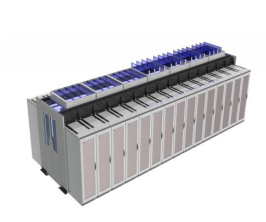
Section 140.9(a) provides minimum requirements for conditioning of computer rooms. A computer room is defined in §100.1 Definitions as "a room whose primary function is to house electronic equipment and that has a design equipment power density exceeding 20 watts/ft2 of conditioned floor area."
There are no mandatory measures specific to computer rooms. The equipment efficiencies in §110.1 and §110.2 apply.
The following is a summary of the measures in this section:
a. Air or water side economizer - §140.9(a)1
b. Restriction on reheat or recool - §140.9(a)2
c. Limitations on the type of humidification - §140.9(a)3
d. Fan power limitations - §140.9(a)4
e. Variable-speed fan control - §140.9(a)5, and
f. Containment - §140.9(a)6
10.4.3.1 Economizers
This section requires integrated air or water economizers. If an air economizer is used to meet this requirement, it must be designed to provide 100% of the expected system cooling load at outside temperatures of 55°F drybulb (Tdb) with a coincident 50°F wetbulb (Twb). This is different from the non-computer room economizer regulations (§140.4(e)), which require that an air economizer must supply 100 percent of the supply air as outside air. A computer room air economizer does not have to supply any outside air if it has an air-to-air heat exchanger that can meet the expected load at the conditions specified and can be shown (through modeling) to consume no more energy than the standard air economizer. Furthermore, air handlers with cooling capacity greater than 54 kBtuh and air economizers must be equipped with fault detection and diagnostic devices meeting §120.2(i).
If a water economizer is used to meet this requirement, it must be capable of providing 100% of the expected system cooling load at outside temperatures of 40°F drybulb with a coincident 35°F wetbulb.
See Chapter 4 for a description of integrated air and water economizers and implementation details.
There are several exceptions to this requirement:
1. Exception 1 to §140.9(a)1: Computer rooms with cooling capacity <5 tons in a building that does not have any economizers. This exception is different from the 54,000 Btu-h (4.5 ton) exception in 140.4(e) for noncomputer rooms in two important ways. First, the computer room exception refers to the cooling capacity of all systems serving the computer room, whereas the noncomputer room regulation refers to each cooling system serving the building. Second, the computer room exception applies only if none of the other cooling systems in the building includes an economizer. Even a 1-ton computer room would have to be served by an existing cooling system with an economizer. (See Exception 4 below.) The analysis for this requirement was performed using a 5-ton AC unit with an air/air heat exchanger. Even with the added cost and efficiency loss of a heat exchanger, the energy savings in all of the California climates justified this requirement.
2. Exception 2 to §140.9(a)1: New cooling systems serving an existing computer room in an existing building up to a total of 50 tons of new cooling equipment per building. This exception permits addition of new IT equipment to an existing facility that was originally built without any economizers.
This exception recognizes that an existing space with capacity for future expansion may not have been sited or configured to accommodate access to outside air.
Above 50 tons of capacity (~175kW of IT equipment load), you would be forced to either provide economizer cooling or offset the energy loss by using the performance approach. Ways to meet this requirement include:
a. Provide the new capacity using a new cooling system that has a complying air or water economizer.
b. If the facility has a chilled water plant, install an integrated water-side economizer with a minimum capacity equal to the new computer room cooling load. Water-side economizers can be added to both air and water cooled chilled water plants.
3. Exception 3 to §140.9(a)1: New cooling systems serving a new computer room up to a total of 20 tons of new cooling load in an existing building.
This is similar to the previous exception, but the capacity threshold is lower because you can locate a new space in a location suitable for an integrated economizer.
4. Exception 4 to §140.9(a)1: Applies to computer rooms in a larger building with a central air-handling system and complying air-side economizer that can fully condition the computer rooms on weekends and evenings when the other building spaces are unoccupied. This exception allows the computer rooms to be served by fan coils or split system direct expansion (DX) units as long as the following conditions are met:
a. The economizer system on the central air-handling unit is sized sufficiently that all the computer rooms are less than 50% of the total airflow capacity.
b. The central air-handling unit is configured to serve only the computer rooms if all the other spaces are unoccupied.
c. The supplemental cooling systems for the computer rooms are locked out when the outside air drybulb temperature is below 60°F and the noncomputer room zones are less than 50% of the design airflow.
Example 10-5
Question
A new data center is built with a total computer room load of 1,500 tons. If the computer rooms are all served using recirculating chilled water computer room air-handling units (CRAHs) in in-row air-handling units (IRAHs), would this data center meet the requirements of §140.9(a)1 if the chilled water plant had a water-side economizer that complied with the requirements of §140.4(e)?
Answer
Yes, if the economizer can meet 100 percent of the 1,500 ton load at 40°F drybulb and 35°F wetbulb. The design conditions in §140.9(a) would require a different heat exchanger and cooling towers than the conditions in §140.4(e) for nonprocess spaces for a given expected load. The load on the cooling towers, while in economizer-only mode, is lower than the design load even if the computer room load is constant because the towers do not have to reject the heat from the chillers. Furthermore, there are no redundancy requirements in the energy code. Many data centers have more cooling towers than needed to meet the design load so that the design load can be met even if one or more towers is not available. If the system is capable of running all cooling towers in economizer-only mode, then all towers can be included in the calculation for determining compliance with this requirement.
Example 10-6
Question
A new data center is built with chilled water CRAH units sized to provide 100% of the cooling for the IT equipment. The building also has louvered walls that can open to bring in outside air and fans on the roof that can exhaust air. Does this design meet the requirements of §140.9(a)1?
Answer
Yes provided that all the following are true:
The economizer system moves sufficient air so that it can fully satisfy the design IT equipment loads with the CRAH units turned off and the outside air drybulb temperature at 55°F.
The control system provides integrated operation so that the chilled water coils in the CRAH units are staged down when cool outside air is brought into the data center.
The economizer system is provided with a high limit switch that complies with §140.4(e). Although fixed drybulb switches are allowed in §140.4(e) they are not recommended in this application as the setpoints were based on office occupancies. A differential drybulb switch would provide greater energy savings.
Moreover, because the system economizer is separate from the air handler, FDD is not required.
Example 10-7
Question
A new office building has a central air system with an air-side economizer that complies with §140.4(e). This building has two Intermediate Distribution Frame (IDF) rooms with split system DX units one is 4 tons of capacity and the other is 7-1/2 tons of capacity. Do the IDF rooms meet the requirements of the Energy Standards?
Answer
Not necessarily. Both IDF rooms are required to be served by the central air system economizer of the building. The 4 ton IDF room does not meet Exception 1 to §140.9(a) because it is a building with an economizer. Per Exception 4 to §140.9(a)11 the IDF rooms can also be served by split-system DX units without economizers if they are also served by variable air volume (VAV) boxes from the VAV reheat system. The DX units must be off when the VAV reheat system has enough spare capacity to meet the IDF loads. The VAV reheat system must be at least twice the capacity of all the IDF rooms. When the office spaces are expected to be unoccupied (e.g., at night), the VAV boxes must be shut so that the VAV system can serve only the IDF rooms.
Example 10-8
Question
A new data center employs rear door heat exchangers that are cooled entirely with water that comes from a closed-circuit fluid cooler. Does this design meet the economizer requirements of §140.9(a)1?
Answer
Yes. The standard definitions for economizer (both air and water) both have the phrase "to reduce or eliminate the need for mechanical cooling." In turn, the definition of mechanical cooling is "lowering the temperature within a space using refrigerant compressors or absorbers, desiccant dehumidifiers, or other systems that require energy from depletable sources to directly condition the space." Since this system does not use compressors, it complies.
Figure 10-4: Example of Water-Side Economizer Retrofit on a Chilled Water Plant With Air-Cooled Chillers

10.4.3.2 Reheat/Recool
§140.9(a)2 prohibits reheating, recooling or simultaneous heating and cooling in computer rooms. Furthermore, the definition of cooling includes both mechanical cooling and economizers. This provision is to prohibit use of CRAC and CRAH units with humidity controls that include reheat coils.
10.4.3.3 Humidification
140.9(a)3 prohibits the use of nonadiabatic humidification for computer rooms. The requirement of humidity control in computer rooms is controversial. On the low humidity side, humidification was provided to reduce the risk of electrostatic discharge. On the high humidity side, the concern has been printed circuit board failure due to circuit board metallic filament formations known as conductive anodic filaments (CAF). For both of these issues, there is insufficient evidence that the risks are adequately addressed through the use of humidity controls. The telecommunications industry standard for central office facilities has no restrictions on either the low or high humidity limits. Furthermore, the Electrostatic Discharge Association (ESDA) removed humidification as a primary control over electrostatic discharge in electronic manufacturing facilities (ANSI/ESDA Standard 20.20) because it was not effective and did not supplant the need for personal grounding. The Energy Standards allows for humidification but prohibits the use of nonadiabatic humidifiers, including the steam humidifiers and electric humidifiers that rely on boiling water as both of these add cooling load with the humidity. The technologies that meet the adiabatic requirement are direct evaporative cooling and ultrasonic humidifiers.
10.4.3.4 Fan Power and Control
§140.9(a)4 and 5
In §140.9(a)4, fan power for equipment cooling computer rooms is limited to 27W/kBtuh of net sensible cooling capacity. Net sensible cooling capacity is the sensible cooling capacity of the coil minus the fan heat. Systems that are designed for a higher airside ΔT (e.g., 25°F) will have an easier time meeting this requirement than systems designed for lower ΔT (e.g., 15°F)
Fan controls, §140.9(a)5, requires that fans serving computer rooms have either variable-speed control or two-speed motors that provide for a reduction in fan motor power to ≤50% of power at design airflow when the airflow is at 67% of design airflow. This applies to chilled water units of all sizes and DX units with a rated cooling capacity of ≥ 5 tons.
10.4.3.5 Containment
Computer rooms with a design IT equipment load exceeding 175 kW per room are required to have containment to separate the computer equipment inlets and outlets. The requirement can be met using hot-aisle containment, cold-aisle containment, or in-rack cooling. Exceptions are provided for:
a. Expansions of existing computer rooms that don't already have containment.
b. Computer racks with a design load of < 1 kW/rack (e.g. network racks).
c. Equivalent energy performance demonstrated to the AHJ through use of CFD or other analysis tools.
Figure 10-5: Example of Aisle Containment Using Chimney Racks

Figure 10-6: Example of Aisle Containment Using Hard Partitions and Doors

Healthcare facilities are not required to meet Section 140.9(a)
The application to additions and alternations is covered under each measure.